
1. Diploid cell - one which contains pairs of homologous chromosomes.
Haploid cell - one which contains one member of each homologous chromosome pair.
Press here to go back to the readings. press
2. See figure below. The nucleus contains six chromosomes, three
pair. The long red and blue structures would represent one pair,
the medium red and blue structures would represent the second pair and
the short red and blue structures would represent the third pair.
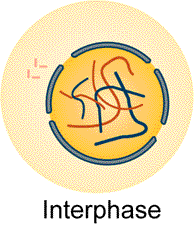
Press here to go back to the readings. press
3. The cell in the figure is diploid because the chromosomes are present
in pairs.
Press here to go back to the readings. press
4. The correct answer is "a". This cell represents the G1 stage.
The DNA has not replicated and there are six chromosomes (three pair).
Press here to go back to the readings. press
5. See figure below. Note the chromosomes consists of two chromatids.
There are three pair of chromosomes. One long red and blue pair, one medium
red and blue pair and one short red and blue pair.
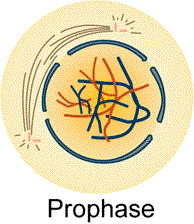
Press here to go back to the readings. press
6. The answer is "c". There are six chromosomes and three pairs.
Press here to go back to the readings. press
7. The answer is "d". Since there are six chromosomes and each chromosome
consists of two chromatids, there are twelve chromatids present in the
nucleus.
Press here to go back to the readings. press
8. The answer is "b". Three tetrads. Tetrads consists of a homologous
chromosome pair attracted in a manner that the four chromatids are lying
next to one another.

Press here to go back to the readings. press
k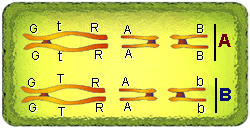
9. The answer is "b". There are three homologous pair. The genes
"G, T and R" are on one pair, gene "A" on the second pair and "B" on the
third pair
.
Press here to go back to the readings. press
k
10. The answer is "c". Homologous chromosomes have the same gene sequence.
In the figure above chromosomes "S" and "U" have the same gene sequence.
Press here to go back to the readings. press
k
11. The answer is "a". Tetrads would consist of two chromosomes,
four chromatids with the same gene sequence. ("S" and "U" or "T" and "V")
Press here to go back to the readings. press
12. The answer is "b". Each centromere contains two kinetochores. Each
chromatid has a single kinetochore.
Press here to go back to the readings. press
13. The correct answer is "b".
Press here to go back to the readings. press
14. The correct answer is "a". Only one chromosome of each homologous
pair will move towards the centriole organizing poles during anaphase
I. In this figure there are six chromosomes and three pairs.
What might be confusing is that each chromosome at this stage consists
of two chromatids.
Press here to go back to the readings. press
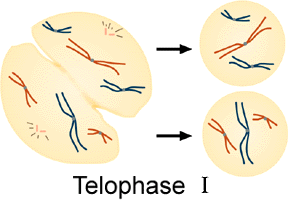
15. The correct answer is "a". In each of these cells there are
three chromosomes (made up of two chromatids) and no pair.
Press here to go back to the readings. press
16. The correct answer is "a". True.
Press here to go back to the readings. press

17. The answer is "b". Three chromosomes. Each cell is haploid
at this stage.
Press here to go back to the readings. press
See answer below.

18. The answer is "c". There are six chromatids per cell.
Press here to go back to the readings. press

19. The corret answer is "b". Each of the three chromosomes have only
one centromere.
Press here to go back to the readings. press
See answer below.

20. The answer is "a". There are no pairs.
Press here to go back to the readings. press
Press here to go back to the readings. press
22. The answer is "b". This figure shows three chromosomes per cell
and each chromosome consists of two chromatids.
k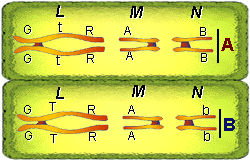
Press here to go back to the readings. press
23. The answer is "no". Note that in cell "A" the gene (B) is
present and in cell "B" (b) is present.
k
Press here to go back to the readings. press
k
24. The answer is "b". There are going to be three chromatids pulled
to each pole - one long, one medium and one short. There will be a total
of four poles formed.
Press here to go back to the readings. press
25. The answer is "b". Three chromosomes - one long, one medium and
one short.
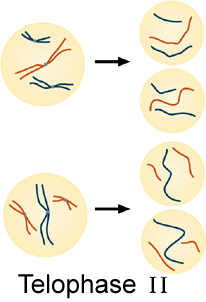
The figure below shows the chromosomes with genes.
k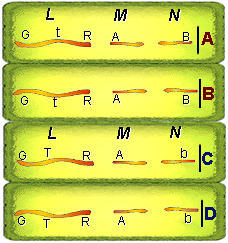
Note that two of the cells contain a "B" and two "b".
Press here to go back to the readings. press
26. The answer is "b". The chromosomes are made up of only a
single chromatid.
Press here to go back to the readings. press
27. The answer is "d". 46 in somatic cells.
Press here to go back to the readings. press
28. The answer is "b". You received one half from your mother and one
half form your father.
Press here to go back to the readings. press
29 The answer is "a". These cells are haploid
Press here to go back to the readings. press
30. The answer is "d". Egg, sperm and gametes are all haploid.
Press here to go back to the readings. press
For information on how to use this page, go to How
to Use This Site.
Created by the Center for Learning Technologies, Academic Technology Services.
Last modified October 22, 1997.